#Advanced driver assistance features
Explore tagged Tumblr posts
Text
Tesla Autopilot vs Full Self Driving: What’s the difference?
The main difference between Tesla Autopilot vs Full Self Driving lies in the feature set. Autopilot is a standard feature offering basic highway driving assistance, while Full Self Driving (FSD) adds advanced features like automatic city street navigation, smart summon, and traffic light recognition.
Autopilot is suitable for those who need basic hands-on assistance, whereas FSD caters to drivers wanting cutting-edge autonomy—albeit supervised. Choosing between the two depends on your budget and how much automation you’re comfortable relying on.

#Tesla Autopilot vs Full Self Driving#Tesla Full Self Driving#Advanced Driver Assistance Systems#Electric Car Features#Tesla Technology
0 notes
Text
Volvo C40 Recharge E80: Luxury Electric SUV Overview
₹62.95 Lakh The Volvo C40 Recharge E80 represents a significant step in the luxury SUV market as a fully electric, environmentally conscious vehicle. It combines high performance with advanced safety, comfort, and cutting-edge technology, making it a competitive contender in the growing electric vehicle (EV) segment. Performance and Powertrain Electric Powertrain: Equipped with a 78 kWh…
#Advanced Driver Assistance Systems#AWD Electric Vehicle#Connected Car Features#Eco-Friendly Cars#Electric Powertrain#Electric SUV#Electric Vehicle Charging#Electric Vehicle Technology#EV Interior Comfort#EV Safety Features#Long Range EV#Luxury EV#performance SUV#premium electric SUV#Sustainable Vehicles#Volvo C40 Recharge#Volvo Cars#Volvo Design#Volvo EV Range#Zero Emission SUV
0 notes
Text
2024 Hyundai Santa Fe Hybrid FWD Review
The 2024 Hyundai Santa Fe Hybrid FWD ushers in a bold new era for family SUVs, showcasing a daring departure from its predecessor in both design and functionality. Hyundai has reimagined the Santa Fe, crafting a seven-seater that stands out with its striking looks and impressive features. It’s not just the exterior that has undergone a transformation; the Santa Fe Hybrid promises a well-rounded…
#2024 Santa Fe#Adaptive Cruise#advanced safety#Autonomous Braking#Blind-Spot Assist#cargo space#Child-Friendly#Climate Control#Comfort#Design#Driver Attention#driving experience#Eco-Friendly#EV Mode#family SUV#family vehicle#fuel efficiency#fuel savings#FWD#Head-Up Display#hybrid SUV#Hyundai#Infotainment#interior comfort#lane keeping#Long Trips#maintenance#Modern Features#performance#powertrain
0 notes
Text

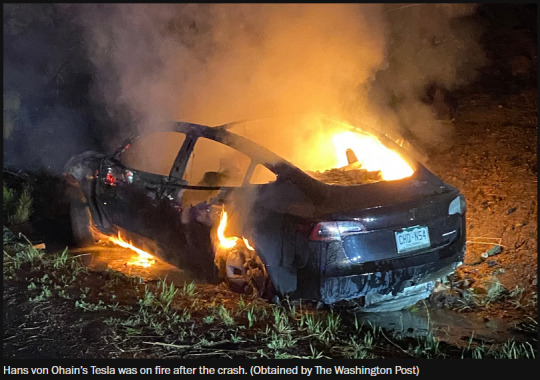
on the way home, the Tesla Model 3 barreled into a tree and exploded in flames, killing von Ohain, a Tesla employee and devoted fan of CEO Elon Musk. Rossiter, who survived the crash, told emergency responders that von Ohain was using an “auto-drive feature on the Tesla” that “just ran straight off the road,” according to a 911 dispatch recording obtained by The Washington Post. In a recent interview, Rossiter said he believes that von Ohain was using Full Self-Driving, which — if true — would make his death the first known fatality involving Tesla’s most advanced driver-assistance technology.
Finally, they have a witness. A survivor of an Autopilot mishap who can testify that the driver was using Full Self Driving mode at the time of the crash.
See, this has been impossible thus far because (1) survivors are rare, and (2) Teslas are programmed to automatically disengage Self-Driving milliseconds before the crash so that when investigators review the telemetry it clearly shows FSD wasn't turned on.
And due to this technicality, Musk has been able to claim Autopilot has never killed anybody. Until now.
11K notes
·
View notes
Text

2026 Pontiac GTO
The 2026 Pontiac GTO is a highly anticipated revival of the iconic muscle car, blending classic design elements with modern performance and technology. Drawing inspiration from its predecessors, the 2026 model features a sleek, aggressive exterior with bold lines and a prominent front grille. Under the hood, it boasts a powerful engine lineup, including a 6.2L V8 engine delivering impressive horsepower and torque. The interior is designed for comfort and performance, with premium materials and advanced technology features. Safety is a priority, with the inclusion of modern driver assistance systems. Overall, the 2026 Pontiac GTO aims to honor its legacy while embracing the future of automotive engineering.
236 notes
·
View notes
Text
Elon Musk has pledged that the work of his so-called Department of Government Efficiency, or DOGE, would be “maximally transparent.” DOGE’s website is proof of that, the Tesla and SpaceX CEO, and now White House adviser, has repeatedly said. There, the group maintains a list of slashed grants and budgets, a running tally of its work.
But in recent weeks, The New York Times reported that DOGE has not only posted major mistakes to the website—crediting DOGE, for example, with saving $8 billion when the contract canceled was for $8 million and had already paid out $2.5 million—but also worked to obfuscate those mistakes after the fact, deleting identifying details about DOGE’s cuts from the website, and later even from its code, that made them easy for the public to verify and track.
For road-safety researchers who have been following Musk for years, the modus operandi feels familiar. DOGE “put out some numbers, they didn’t smell good, they switched things around,” alleges Noah Goodall, an independent transportation researcher. “That screamed Tesla. You get the feeling they’re not really interested in the truth.”
For nearly a decade, Goodall and others have been tracking Tesla’s public releases on its Autopilot and Full Self-Driving features, advanced driver-assistance systems designed to make driving less stressful and more safe. Over the years, researchers claim, Tesla has released safety statistics without proper context; promoted numbers that are impossible for outside experts to verify; touted favorable safety statistics that were later proved misleading; and even changed already-released safety statistics retroactively. The numbers have been so inconsistent that Tesla Full Self-Driving fans have taken to crowdsourcing performance data themselves.
Instead of public data releases, “what we have is these little snippets that, when researchers look into them in context, seem really suspicious,” alleges Bryant Walker Smith, a law professor and engineer who studies autonomous vehicles at the University of South Carolina.
Government-Aided Whoopsie
Tesla’s first and most public number mix-up came in 2018, when it released its first Autopilot safety figures after the first known death of a driver using Autopilot. Immediately, researchers noted that while the numbers seemed to show that drivers using Autopilot were much less likely to crash than other Americans on the road, the figures lacked critical context.
At the time, Autopilot combined adaptive cruise control, which maintains a set distance between the Tesla and the vehicle in front of it, and steering assistance, which keeps the car centered between lane markings. But the comparison didn’t control for type of car (luxury vehicles, the only kind Tesla made at the time, are less likely to crash than others), the person driving the car (Tesla owners were more likely to be affluent and older, and thus less likely to crash), or the types of roads where Teslas were driving (Autopilot operated only on divided highways, but crashes are more likely to occur on rural roads, and especially connector and local ones).
The confusion didn’t stop there. In response to the fatal Autopilot crash, Tesla did hand over some safety numbers to the National Highway Traffic Safety Administration, the nation’s road safety regulator. Using those figures, the NHTSA published a report indicating that Autopilot led to a 40 percent reduction in crashes. Tesla promoted the favorable statistic, even citing it when, in 2018, another person died while using Autopilot.
But by spring of 2018, the NHTSA had copped to the number being off. The agency did not wholly evaluate the effectiveness of the technology in comparison to Teslas not using the feature—using, for example, air bag deployment as an inexact proxy for crash rates. (The airbags did not deploy in the 2018 Autopilot death.)
Because Tesla does not release Autopilot or Full Self-Driving safety data to independent, third-party researchers, it’s difficult to tell exactly how safe the features are. (Independent crash tests by the NHTSA and other auto regulators have found that Tesla cars are very safe, but these don’t evaluate driver assistance tech.) Researchers contrast this approach with the self-driving vehicle developer Waymo, which often publishes peer-reviewed papers on its technology’s performance.
Still, the unknown safety numbers did not prevent Musk from criticizing anyone who questioned Autopilot’s safety record. “It's really incredibly irresponsible of any journalists with integrity to write an article that would lead people to believe that autonomy is less safe,” he said in 2018, around the time the NHTSA figure publicly fell apart. “Because people might actually turn it off, and then die.”
Number Questions
More recently, Tesla has continued to shift its Autopilot safety figures, leading to further questions about its methods. Without explanation, the automaker stopped putting out quarterly Autopilot safety reports in the fall of 2022. Then, in January 2023, it revised all of its safety numbers.
Tesla said it had belatedly discovered that it had erroneously included in its crash numbers events where no airbags nor active restraints were deployed and that it had found that some events were counted more than once. Now, instead of dividing its crash rates into three categories, "Autopilot engaged,” “without Autopilot but with our active safety features,” and “without Autopilot and without our active safety features,” it would report just two: with and without Autopilot. It applied those new categories, retroactively, to its old safety numbers and said it would use them going forward.
That discrepancy allowed Goodall, the researcher, to peer more closely into the specifics of Tesla’s crash reporting. He noticed something in the data. He expected the “without Autopilot” number to just be an average of the two old “without Auptilot” categories. It wasn’t. Instead, the new figure looked much more like the old “without Autopilot and without our active safety features” number. That’s weird, he thought. It’s not easy—or, according to studies that also include other car makes, common—for drivers to turn off all their active safety features, which include lane departure and forward collision warnings and automatic emergency braking.
Goodall calculated that even if Tesla drivers were going through the burdensome and complicated steps of turning off their EV’s safety features, they’d need to drive way more miles than other Tesla drivers to create a sensible baseline. The upshot: Goodall wonders if Tesla is allegedly making its non-Autopilot crash rate look higher than it is—and so the Autopilot crash rate allegedly looks much better by comparison.
The discrepancy is still puzzling to the researcher, who published a peer-reviewed note on the topic last summer. Tesla “put out this data that looks questionable on first glance—and then you look at it, and it is questionable,” he claims. “Instead of taking it down and acknowledging it, they change the numbers to something that is even weirder and flawed in a more complicated way. I feel like I’m doing their homework at this point.” The researcher calls for more transparency. So far, Tesla has not put out more specific safety figures.
Tesla, which disbanded its public relations team in 2021, did not reply to WIRED’s questions about the study or its other public safety data.
Direct Reports
Tesla is not a total outlier in the auto industry when it comes to clamming up about the performance of its advanced technology. Automakers are not required to make public many of their safety numbers. But where tech developers are required to submit public accounting on their crashes, Tesla is still less transparent than most. One prominent national data submission requirement, first instituted by the NHTSA in 2021, requires makers of both advanced driver assistance and automated driving tech to submit public data about its crashes. Tesla redacts nearly every detail about its Autopilot-related crashes in its public submissions.
“The specifics of all 2,819 crash reports have been redacted from publicly available data at Tesla's request,” says Philip Koopman, an engineering professor at Carnegie Mellon University whose research includes self-driving-car safety. “No other company is so blatantly opaque about their crash data.”
The federal government likely has access to details on these crashes, but the public doesn’t. But even that is at risk. Late last year, Reuters reported that the crash-reporting requirement appeared to be a focus of the Trump transition team.
In many ways, Tesla—and perhaps DOGE—is distinctive. “Tesla also uniquely engages with the public and is such a cause célèbre that they don’t have to do their own marketing. I think that also entails some special responsibility. Lots of claims are made on behalf of Tesla,” says Walker Smith, the law professor. “I think it engages selectively and opportunistically and does not correct sufficiently.”
Proponents of DOGE, like those of Tesla, engage enthusiastically on Musk’s platform, X, applauded by Musk himself. The two entities have at least one other thing in common: ProPublica recently reported that there is a new employee at the US Department of Transportation—a former Tesla senior counsel.
22 notes
·
View notes
Text

How can RideBoom ensure auto rickshaw drivers have a stable income and can plan their finances effectively?
RideBoom can take several steps to ensure that auto rickshaw drivers have a stable income and can effectively plan their finances. By implementing these measures, RideBoom can provide drivers with a reliable source of income and the tools they need to manage their finances efficiently. Here are some ways RideBoom can achieve this:
Guaranteed Minimum Earnings: RideBoom can introduce a guaranteed minimum earnings program for auto rickshaw drivers. This program would ensure that drivers earn a minimum amount for each hour or shift they work, providing them with a stable income [1].
Scheduled Shifts: RideBoom can allow drivers to schedule their shifts in advance. This feature would enable drivers to plan their working hours and allocate time for other personal or financial commitments [1].
Fare Estimation: RideBoom can provide drivers with fare estimation tools that allow them to calculate the approximate earnings for each ride. By knowing the expected fare in advance, drivers can plan their finances more effectively [1].
Financial Planning Resources: RideBoom can offer financial planning resources and tools to auto rickshaw drivers. These resources can include budgeting guides, savings tips, and access to financial advisors who can help drivers plan for their future [1].
Incentive Programs: RideBoom can introduce incentive programs that reward drivers for their performance and loyalty. These programs can include bonuses for completing a certain number of rides or meeting specific targets, providing drivers with additional income and stability [1].
Driver Support: RideBoom can provide comprehensive support to auto rickshaw drivers, including assistance with financial management. This can include access to financial literacy training, workshops, and resources that help drivers understand and manage their finances effectively [1].
#rideboom#rideboom app#delhi rideboom#ola cabs#biketaxi#uber#rideboom taxi app#ola#uber driver#uber taxi
23 notes
·
View notes
Text
youtube
Skoda Elroq review | Wanna buy one? Watch this first!
Discover the all-new Škoda Elroq, the latest electric SUV from Škoda, combining cutting-edge technology, impressive range, and a sleek modern design. As the brand’s first compact electric SUV, the Elroq is built on the MEB platform, offering a spacious interior, advanced infotainment, and top-tier safety features. 🔋 Battery & Range – Expected to offer over 300 miles (500 km) per charge ⚡ Performance – Instant electric power with multiple motor options 📱 Technology – State-of-the-art infotainment system and driver-assist features 🌍 Sustainability – Eco-friendly materials and zero emissions Whether you're looking for a stylish EV for city driving or a capable SUV for long-distance travel, the Škoda Elroq delivers. Stay tuned for the latest updates, pricing, and release date!
#Škoda#Czech Republic#made in europe#affordable EV#electric car#electric vehicle#Europe#ev review#ev test drive#long range EV#Youtube
4 notes
·
View notes
Text
Mercedes-G580-EQ
The Mercedes-Benz G 580 with EQ Technology is the all-electric iteration of the iconic G-Class SUV, blending its renowned off-road capabilities with modern electric performance.
Performance and Powertrain:
Electric Motors: Equipped with four electric motors, one at each wheel, delivering a combined output of 587 horsepower.
Acceleration: Capable of accelerating from 0 to 100 km/h in approximately 4.7 seconds.
Top Speed: Electronically limited to 180 km/h.
Battery and Range:
Battery Capacity: Features a 116 kWh lithium-ion battery pack integrated into the ladder-frame chassis.
Range: Offers a WLTP-certified range of up to 473 kilometers on a single charge.
Charging: Supports fast charging, capable of recharging from 10% to 80% in approximately 32 minutes using a 200 kW DC charger.
Dimensions:
Length: 4,863 mm
Width: 2,187 mm
Height: 1,983 mm
Wheelbase: 2,890 mm
Off-Road Capabilities:
Maintains the G-Class’s legendary off-road prowess with features such as:
Independent electric motors allowing precise torque distribution.
Advanced four-wheel-drive system enhancing traction across various terrains.
Robust construction ensuring durability in challenging conditions.
Interior and Features:
Combines luxury with technology, offering:
High-quality materials and craftsmanship.
State-of-the-art infotainment system with intuitive controls.
Comprehensive driver-assistance features for enhanced safety and convenience.
Pricing and Availability in India:
Price: The G 580 with EQ Technology is priced at ₹3 crore (ex-showroom) in India.
Availability: Initial units have been sold out, with bookings for the next batch expected to commence in the third quarter of 2025.
For the most current information on availability and to explore financing options, it is advisable to contact an authorized Mercedes-Benz dealer or visit the official Mercedes-Benz India website.
3 notes
·
View notes
Text
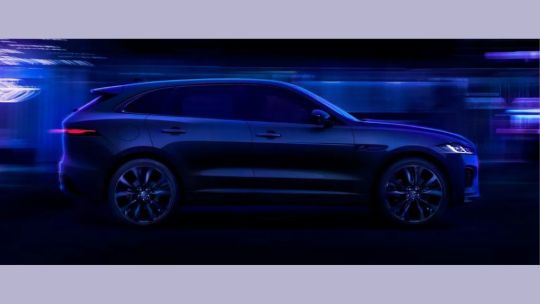
2025 Jaguar F-PACE: What's New and Exciting?
Providing users with the ideal combination of performance, practicality and luxury, the award-winning Jaguar F-PACE is an exceptional SUV well-known for its striking performance. The car focuses on family, and the latest F-PACE is about speed and performance. Comfort boosts its existence with added state-of-the-art technology that constantly keeps the driver updated for optimal driving experiences.
Exterior
The exterior of the 2025 Jaguar F-PACE has powerful proportions and an imposing silhouette. Check out the looming clamshell hood that runs along the vehicle's chiseled edges. The front adorns a distinctive grille, signature DRL, and LED headlights, all of which are enhanced to provide excellent visibility.
Interiors
The interior of the Jaguar F-PACE is uncluttered and bestows top-notch convenience to its users. The sliding panoramic roof allows natural light into the cabin whenever you wish. Besides, the Windsor leather Performance seats ensure optimal comfort along with ergonomics and ambient lighting. Commuters can experience a stress-free ride in a first-class environment.
Handling
Get real-time updates on the road that's ahead of you. Besides, you get optional Adaptive Dynamics, which automatically adjusts the gears, suspension and steering. Configurable Dynamics lets you take complete control of the vehicle and drive at your own pace and style.
AWD
A standard in the F-PACE, the All-Wheel-Drive lets you drive on the road with absolute confidence. The AdSR or Adaptive Surface Response helps you in complex and unpredictable conditions ensuring optimum traction while consistently analyzing the viability of the road ahead of you.
Technology
One of the most irresistible features of the Jaguar Luxury car, the F-PACE, encompasses technology that facilitates enhanced driving. The Head-up Display and the 12.3-inch Interactive Driver Display (IDD) bring all information to your eye's level for your journey. You can stay seamlessly connected and get all the data you need at your fingertips with the Pivi Pro system integrated into the 11.4-inch curved Touchscreen equipped with Alexa Voice Control. Finally, with Wireless Charging, you can power up the device of your choice.
FAQs
What are the key changes and updates for the 2025 Jaguar F-PACE model year?
Some key updates made are the Black Exterior Pack, Privacy Glass, Gloss Black roof rails, AHBA or Auto High Beam Assist, and more.
What are the different trim levels available for the 2025 Jaguar F-PACE in Canada?
The Jaguar F-PACE wields at least three trim levels -- SVR 575 Edition, P250 R-Dynamic S, and P400 R-Dynamic S. Visit the Jaguar of Windsor showroom to learn more.
Can you identify some of the technology features included in the 2025 Jaguar F-PACE?
The vehicle allows you to set your cruising speed and automatically adapts to slow traffic. It also comes with recalibrated handling and the Dynamic Launch, among other features.
How does the 2025 Jaguar F-PACE handle Canadian winter driving conditions?
The Jaguar F-PACE is an all-wheel drive that provides advanced traction control and excellent grip, making it one of the best vehicles for Canadian winter conditions.
Contact Us
Get the Jaguar F-PACE for sale at our showroom. Walk into the best Jaguar dealership near me to get an overview of the Jaguar F-PACE price as you get to take it for a test drive.
2 notes
·
View notes
Text

Utes for Sale: Power, Practicality, and Performance in One Vehicle
Utes, short for utility vehicles, are a popular choice among drivers who need a blend of functionality, toughness, and everyday comfort. Whether you’re a tradesperson needing a workhorse for the job site, an adventurer seeking off-road capability, or a family looking for a versatile all-rounder, there’s a wide range of utes for sale to suit every need and budget.
Why Choose a Ute?
Utes are designed for both utility and comfort. With powerful engines, large cargo beds, and spacious cabins, they’re ideal for transporting tools, gear, or even the family dog. Many modern utes combine rugged capabilities with advanced technology, offering everything from touchscreen infotainment to driver assistance systems. This makes them equally suited for both work and lifestyle purposes.
In addition to practicality, utes are known for their strong towing capacity and durability. Whether you need to tow a trailer, a boat, or heavy equipment, most utes are up to the task. They also perform well off-road, making them a top pick for outdoor enthusiasts who love to explore beyond the pavement.
Types of Utes Available
When browsing utes for sale, you'll find a range of configurations, including:
Single Cab Utes: Ideal for tradespeople who prioritize cargo space over passenger capacity.
Dual Cab Utes: Great for families or crews, offering extra seating without sacrificing too much tray space.
4x2 and 4x4 Utes: While 4x2 utes are more fuel-efficient and better for city driving, 4x4 utes are built for off-road adventures and tougher jobs.
New vs. Used Utes
Both new and used utes offer excellent value, depending on your needs. New utes come with warranties, updated safety features, and the latest technology, while used utes can be more affordable and may already have aftermarket accessories included. Always check service history and vehicle condition when buying second-hand.
Conclusion
With their unbeatable mix of strength, space, and versatility, utes remain one of the most practical vehicles on the market. Whether for work, play, or everyday use, there are countless utes for sale to match your requirements. Take the time to compare models, test drive your options, and choose a ute that delivers both performance and reliability—on and off the road.
2 notes
·
View notes
Text
Porsche Taycan Turbo: High-Performance Electric Coupe Review
₹2.53 Cr General Overview The Taycan Turbo is a high-performance electric coupe that marks Porsche’s entry into the electric vehicle market. With its sophisticated design and Porsche’s signature performance characteristics, the Taycan is built to offer an exhilarating driving experience while being environmentally friendly. Model: Taycan Turbo Type: Coupe Seating Capacity: 5 seats Boot…
#acceleration#Adaptive cruise control#Advanced Driver Assistance Systems#Advanced Safety Features#aerodynamics#All-Wheel Drive#Android Auto#Apple CarPlay#dual-zone climate control#Eco-Friendly Vehicle#electric motors#electric range#Electric vehicle#Fast charging#high-performance#high-performance driving#infotainment#Lane Keep Assist#luxury coupe#Luxury interior#Matrix LED headlights#Porsche Design#Porsche engineering#Porsche Taycan Turbo#regenerative braking#sport car#top speed#Wireless charging#Zero Emissions
0 notes
Text
How to Hire an Airport Limo: 10 Tips for First-Time Users

Whether planning a summer vacation, flying out for a destination wedding, or returning home after a business trip, navigating the airport transfer can be stressful, especially in a bustling city like Toronto. That’s where a Toronto airport limousine rental becomes your best ally: a luxurious, reliable, and surprisingly affordable way to upgrade your travel experience.
Here’s your go-to Ultimate Guide for booking the best airport limo service in Toronto and making the most of your ride. We’ve broken it down into must-know tips, questions to ask, and common mistakes to avoid—whether you’re a first-time user or someone looking to switch to a better provider.
Why Should I Book My Toronto Airport Limo Early?
Summer is the peak season in Toronto—not just for tourism, but also for events like weddings, anniversaries, proms, and family vacations. Limo bookings, particularly for Toronto Pearson and Billy Bishop Airports, fill up quickly.
Pro Tip: To guarantee availability and get the vehicle you prefer, it’s best to book your Pearson Airport limo service 48 to 72 hours ahead of time.
What Types of Limo Vehicles Can I Rent?
Choose a vehicle based on your group size, luggage needs, and occasion:
Couples: Luxury sedans or black car service.
Families: SUV, executive van, or minivan limo.
Large Groups: Stretch limousine, party bus, or shuttle van.
Ask for photos or check the provider’s website gallery. Double-check the trunk capacity and legroom in advance to prevent any unexpected issues.
Is the Limo Company Licensed and Insured?
Always check:
Are the vehicles commercially insured?
Are drivers licensed chauffeurs?
Are background checks and drug testing required?
Does the vehicle come equipped with essential safety features like GPS, a fire extinguisher, and a first-aid kit?
Only choose a licensed limo provider in Toronto that meets local and provincial safety standards.
What Does the Price Include? Flat Rate or Hidden Charges?
Pricing structures vary across Toronto limousine services. Some offer flat-rate limo rentals, while others charge per hour or include surcharges.
Ask if your quote includes:
Fuel surcharge.
Parking and waiting time.
Pearson or Billy Bishop airport pickup fees.
Driver gratuity.
Late-night or weekend surcharges.
Be sure to request a clear, itemized invoice within 24 hours of completing your trip. Hidden fees are a red flag.
Does the Chauffeur Have Experience in Toronto Traffic?
Your driver can make or break your ride. A professional airport chauffeur in Toronto should:
Be trained in airport procedures.
Know traffic patterns and detours.
Be punctual, polite, and dressed in formal attire.
Respect your privacy and assist with luggage.
Many airport limo services in Toronto offer real-time flight tracking and automatic rescheduling in case of delays.
How Good Is Customer Support?
Imagine your flight lands late and you can’t reach anyone.
Look for limo companies that offer:
24/7 phone and live chat support.
Real-time updates via SMS or email.
On-call dispatch teams for emergencies.
What’s the Cancellation or Refund Policy?
Plans change. Weather delays happen. Ask these before you book:
What’s the cancellation window?
Is there a fee?
Will I get a refund or only a credit?
Many Toronto airport limousine providers allow cancellations up to 24 hours in advance, while others charge within a shorter timeframe.
Do I Need to Tip My Limo Driver in Toronto?
In 2025, tipping norms in Toronto vary:
Most riders tip 15–20%.
Some services automatically include gratuity in the bill, especially for pre-booked rides.
Check in advance to avoid double tipping.
Where Can I Read Verified Limo Reviews?
Customer reviews are essential for choosing the best limo service in Toronto. Search on:
Google Business Profiles
Yelp
Tripadvisor
Look for patterns in complaints and whether the company responds professionally to negative reviews. Accountability is a good sign.
First-Time Airport Limo Mistakes to Avoid
Here are the top mistakes travelers make when booking a Toronto airport limo:
Booking last minute during high season.
Choosing a vehicle without confirming luggage capacity.
Assuming all fees are included in the quote.
Not confirming the pick-up location at Pearson or Billy Bishop.
Forgetting to provide the flight number for tracking.
Final Thoughts: Should You Hire a Toronto Airport Limo?
Absolutely. A professional airport limo rental in Toronto ensures a smooth, stylish, and stress-free ride, whether you’re catching a flight or coming home.
Ask the right questions, avoid the common traps, and choose a limo provider that values transparency, safety, and customer care.
Ready to ride in comfort and class?
Book your Toronto airport limo now.
Frequently Asked Questions
1. Are airport limousines still worth it compared to Uber or Lyft in 2025?
Yes, for travelers who value comfort, reliability, and fixed pricing, airport limousines are a better choice, especially during peak seasons when ride-share prices surge and wait times increase. Many also prefer limos for their professional chauffeurs, flight tracking, and premium experience.
2. How early should I book an airport limo during busy travel months?
It’s best to book your limo at least 24–48 hours in advance during summer months or long weekends. This ensures availability, better vehicle selection, and helps you avoid last-minute premium charges.
3. What’s included in a standard airport limousine service in Toronto?
Standard services typically include:
30–60 minutes of free wait time
Luggage assistance
Bottled water
Real-time flight tracking
Some providers may charge extra for child seats, additional stops, or late-night pickups.
4. How much should I tip a limo driver in Canada in 2025?
The standard tip is 10% to 15% of the fare, though many customers now give 15% to 20% for exceptional service, especially if the chauffeur helps with bags or handles delays professionally.
5. What types of airport limos are available for families or group travel?
Options include:
Executive sedans (up to 3 passengers)
Luxury SUVs (up to 6 passengers + ample luggage)
Stretch limos (for special occasions)
Passenger vans or shuttles (for 8+ passengers)
Always confirm luggage capacity before booking for group or family trips.
6. Can I cancel or reschedule an airport limo if my flight changes?
Most top services offer flexible cancellation or rescheduling, especially if flight delays are involved. Look for services with free cancellations up to 2–4 hours before pickup, and always inform them if your flight number or arrival time changes.
#Toronto Travel Tips#airport transfer service#Limo Service Guide#Luxury Travel On A Budget#First Time Travel Advice
2 notes
·
View notes
Text
youtube
The 2025 Bentley Bentayga Speed is the most powerful and high-performance version of Bentley’s luxury SUV lineup.
It is powered by a 4.0-liter twin-turbocharged V8 engine, producing 650 PS and 850 Newton-meters of torque.
This engine delivers a 0 to 100 kilometers per hour acceleration in just 3.4 seconds,with a top speed reaching 310 kilometers per hour, making it the fastest version of the Bentayga to date.
The engine is paired with an 8-speed automatic transmission and an all-wheel-drive system that ensures optimal traction in all driving conditions. This drivetrain configuration allows for smooth power delivery and high-performance capability on both highway and winding roads.
The chassis has been tuned specifically for the Speed variant, featuring a recalibrated SPORT mode with a 15 percent increase in stiffness compared to the standard Bentayga V8.
Full Launch Control is also integrated, providing maximum acceleration from a standstill.
The braking system is upgraded with optional carbon ceramic brakes, delivering a maximum braking torque of 6000 Newton-meters. These are paired with ventilated disc brakes on all four wheels.
The exterior design includes several performance-focused elements. 23-inch wheels come standard, and the Speed model features dark-tint brightware, dark-tint headlamp internals, grey tail lamps with dark-tint bezels, elliptical sports exhaust outlets, and Speed badging on the lower front doors.
Inside the cabin, the Bentayga Speed features a Precision Diamond quilt pattern, combined with dark-tint air vents and an exclusive color split unique to the Speed variant. Materials include high-quality leather and Alcantara trim for both luxury and sporting intent.
Passenger comfort is preserved with seating for up to five, along with advanced climate control, optional rear seat entertainment, and configurable ambient lighting.
The 2025 Bentayga Speed has a kerb weight of 2,508 kilograms, with overall dimensions of 5,144 millimeters in length, 2,010 millimeters in width, and 1,728 millimeters in height.
Cargo capacity is rated at 484 liters.
With increased power, refined handling, and high-end equipment, the 2025 Bentayga Speed stands at the top of Bentley’s SUV range.
Bentley Bentayga Speed 2025 - Technical Specifications
Engine 4.0 liter twin turbocharged V8 petrol Power output 650 PS Torque 850 Newton meters
Transmission 8 speed automatic Drivetrain All wheel drive
0 to 100 km h acceleration 3.4 seconds Top speed 310 kilometers per hour
Fuel tank capacity 85 liters
Kerb weight 2508 kilograms Braking system Optional carbon ceramic brakes with ventilated discs front and rear
Maximum braking torque 6000 Newton meters
Wheels 22 inch or optional 23 inch alloy Tires 295 40 R22
Suspension Adaptive air suspension Chassis tuning 15 percent stiffer in SPORT mode compared to standard V8
Driving modes Sport Comfort Custom and Dynamic ESC with Launch Control
Exhaust system Standard sports exhaust with elliptical outlets optional Titanium Akrapovic exhaust
Exterior features Dark tint brightware dark tint headlamps grey tail lamps Speed badging
Interior features Precision Diamond quilting exclusive Speed color split dark tint air vents leather and Alcantara trim Infotainment High resolution touchscreen Apple CarPlay Android Auto rear seat entertainment available
Driver assistance Adaptive cruise control lane change assist 360 degree parking camera traffic assist
Passenger capacity Five Cargo capacity 484 liters
Dimensions Length 5144 millimeters Width 2010 millimeters Height 1728 millimeters Emissions standard Euro 6 compliant
2 notes
·
View notes
Text
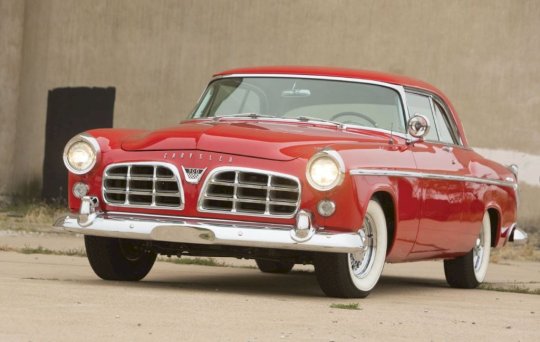
1955 Chrysler C-300
1955 Chrysler C-300: A Glimpse into the Golden Age of American Automobiles
The year 1955 marked a significant milestone in the history of American automotive engineering and design. It was a time when automakers were pushing the boundaries of performance, style, and innovation, and one car that epitomized this spirit was the 1955 Chrysler C-300. Often regarded as the first modern American muscle car, the C-300 not only represented a radical departure from conventional automobiles but also left an enduring legacy in the world of automotive enthusiasts. In this extensive exploration, we delve into the history, design, performance, and cultural impact of the 1955 Chrysler C-300, a symbol of the golden age of American automobiles.
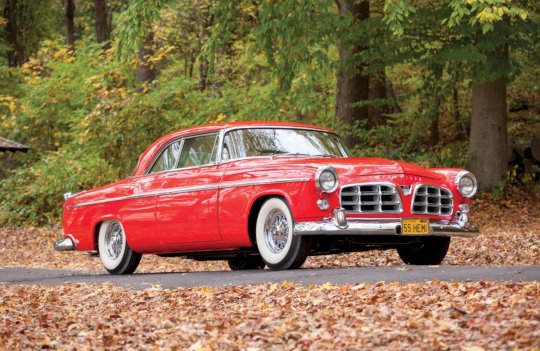
The Birth of a Legend

The 1955 Chrysler C-300, where "C" stood for "Continental," was more than just a car; it was a statement of power, luxury, and style. Born out of Chrysler's desire to reclaim its position as a dominant force in American automobile manufacturing, the C-300 was a bold departure from the brand's previous offerings. It was the brainchild of Chrysler engineer and visionary, Bob Rodger, who saw an opportunity to marry a high-performance V8 engine with a full-sized luxury car, creating a new breed of American automobile.
Design: Classic Elegance with a Touch of Sport
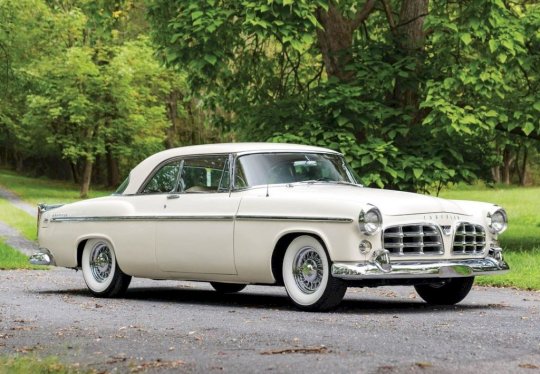
The design of the 1955 Chrysler C-300 was a harmonious blend of classic elegance and sporty aesthetics. The car featured clean, uncluttered lines with a distinctive grille that became one of its signature design elements. The iconic, vertically stacked quad headlights and a wide, bold grille made a bold and unmistakable statement on the road. The subtle yet pronounced fins at the rear added a touch of sophistication and conveyed a sense of motion even when the car was at a standstill.One of the most striking design elements of the C-300 was its two-tone color scheme. Many C-300s featured a contrasting roof color, which accentuated the car's sleek profile. The attention to detail and craftsmanship in the exterior design set the C-300 apart as a true luxury automobile.

The interior of the C-300 was equally impressive. It featured sumptuous materials, tasteful chrome accents, and a driver-centric dashboard. Plush leather seats provided both comfort and support, making long drives a pleasure. The cabin was spacious, allowing passengers to enjoy the ride in style and luxury.
Performance: The Birth of American Muscle
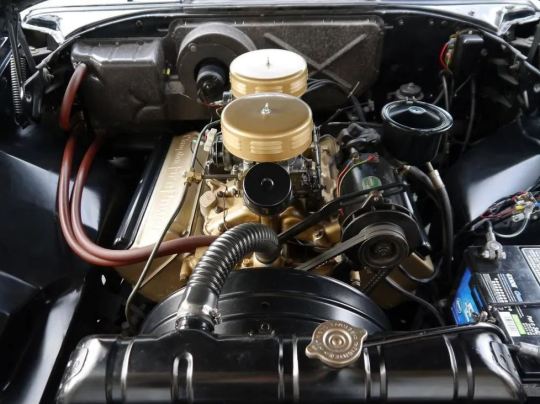
What truly set the 1955 Chrysler C-300 apart was its groundbreaking performance. Under the hood, it was powered by the legendary Hemi V8 engine, which had already gained a reputation for its power and efficiency. In the case of the C-300, the Hemi V8 was tuned to deliver a staggering 300 horsepower, an unprecedented figure for a production car of its time. This made the C-300 the most powerful American car of 1955.The combination of a high-performance engine and advanced engineering made the C-300 a formidable force on the racetrack. In fact, it dominated the NASCAR circuit in its debut year, winning eight of the 16 races it entered. This racing success solidified the C-300's reputation as a true performance car, earning it the nickname "Banker's Hot Rod."
Engineering Innovations

The 1955 Chrysler C-300 introduced several engineering innovations that set the stage for future developments in the automotive industry. The Hemi V8 engine was at the forefront of these innovations. It featured hemispherical combustion chambers, which allowed for better airflow and combustion efficiency. This, in turn, contributed to the engine's remarkable power output and smooth operation.
Another notable innovation was the use of power-assisted brakes and power steering, both of which enhanced the car's drivability and safety. These features were a testament to Chrysler's commitment to providing a superior driving experience.
Cultural Impact and LegacyThe-1955-Chrysler-C-300
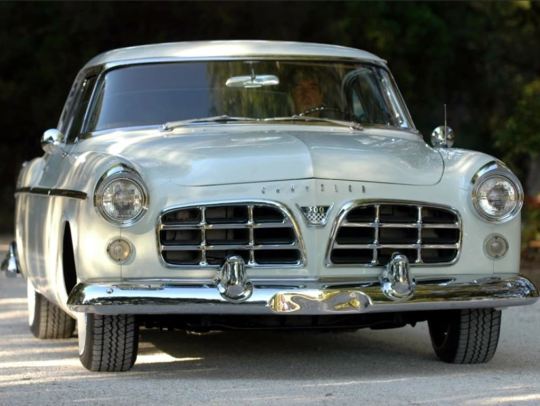
The 1955 Chrysler C-300 had a profound cultural impact that reverberates to this day. It represented a paradigm shift in American automotive manufacturing, heralding the dawn of the muscle car era. The C-300's racing successes on the NASCAR circuit elevated its status and contributed to the popularity of stock car racing in the United States.The car's blend of luxury and performance appealed to a new generation of consumers who desired both power and style. It embodied the American spirit of innovation and ambition, and its success inspired other automakers to explore the concept of high-performance production cars.
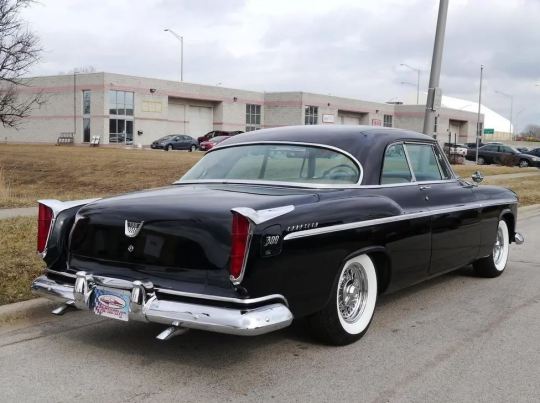
The legacy of the C-300 extends beyond its time. It laid the foundation for the muscle car movement of the 1960s and 1970s, influencing iconic models like the Ford Mustang, Chevrolet Camaro, and Dodge Charger. The C-300 remains a coveted collector's item, a symbol of an era when American automakers pushed the limits of engineering and design.
Conclusion

The 1955 Chrysler C-300 is a testament to the ingenuity, ambition, and creativity that defined the golden age of American automobiles. It represented a bold departure from the norm, marrying luxury with high-performance engineering in a way that captured the imagination of a generation. As a cultural icon and a pioneering force in the automotive world, the C-300 continues to inspire and captivate enthusiasts and collectors, ensuring its enduring legacy in the annals of automotive history.
#Chrysler C-300#Chrysler#C-300#car#cars#muscle car#american muscle#mopar#moparperformance#moparnation#moparworld
85 notes
·
View notes
Text
Automakers and tech developers testing and deploying self-driving and advanced driver-assistance features will no longer have to report as much detailed, public crash information to the federal government, according to a new framework released today by the US Department of Transportation.
The moves are a boon for makers of self-driving cars and the wider vehicle technology industry, which has complained that federal crash-reporting requirements are overly burdensome and redundant. But the new rules will limit the information available to those who watchdog and study autonomous vehicles and driver-assistance features—tech developments that are deeply entwined with public safety but which companies often shield from public view because they involve proprietary systems that companies spend billions to develop.
The government's new orders limit “one of the only sources of publicly available data that we have on incidents involving Level 2 systems,” says Sam Abuelsamid, who writes about the self-driving-vehicle industry and is the vice president of marketing at Telemetry, a Michigan research firm, referring to driver-assistance features such as Tesla’s Full Self-Driving (Supervised), General Motors’ Super Cruise, and Ford’s Blue Cruise. These incidents, he notes, are only becoming “more common.”
The new rules allow companies to shield from public view some crash details, including the automation version involved in incidents and the “narratives” around the crashes, on the grounds that such information contains “confidential business information.” Self-driving-vehicle developers, such as Waymo and Zoox, will no longer need to report crashes that include property damage less than $1,000, if the incident doesn’t involve the self-driving car crashing on its own or striking another vehicle or object. (This may nix, for example, federal public reporting on some minor fender-benders in which a Waymo is struck by another car. But companies will still have to report incidents in California, which has more stringent regulations around self-driving.)
And in a change, the makers of advanced driver-assistance features, such as Full Self-Driving, must report crashes only if they result in fatalities, hospitalizations, air bag deployments, or a strike on a "vulnerable road user,” like a pedestrian or cyclist—but no longer have to report the crash if the vehicle involved just needs to be towed.
“This does seem to close the door on a huge number of additional reports,” says William Wallace, who directs safety advocacy for Consumer Reports. “It’s a big carve-out.” The changes move in the opposite direction of what his organization has championed: federal rules that fight against a trend of "significant incident underreporting" among the makers of advanced vehicle tech.
The new DOT framework will also allow automakers to test self-driving technology with more vehicles that don’t meet all federal safety standards under a new exemption process. That process, which is currently used for foreign vehicles imported into the US but is now being expanded to domestically made ones, will include an "iterative review” that "considers the overall safety of the vehicle.” The process can be used to, for example, more quickly approve vehicles that don’t come with steering wheels, brake pedals, rearview mirrors, or other typical safety features that make less sense when cars are driven by computers.
One company in particular emerges as a winner: Elon Musk’s Tesla, which now will be able to curtail public reporting on its Autopilot and Full Self-Driving (Supervised) features, and may enjoy an easier road to federal safety approval for its upcoming Cybercab, a two-seat, purpose-built robotaxi that does not have a steering wheel or brakes.
“The company that probably benefits the most from that is Tesla,” Abuelsamid says. Though the Transportation Department cited safety as the number one motivator behind the new rules, “there’s nothing in these changes that actually prioritizes safety,” he says.
A spokesperson for the National Highway Traffic Safety Administration did not respond to questions about Tesla. Tesla, which disbanded its press team five years ago, did not respond to a request for comment.
In a video message posted to X, DOT secretary Sean Duffy said the new automated vehicle framework aimed to increase commercial deployment of new car technology. “America is in the middle of an innovation race with China, and the stakes couldn’t be higher,” he said.
In a memo, an NHTSA official said the changes were only the first step in an effort to "improve the efficiency and effectiveness” of the process through which new vehicle tech is allowed on roads.
Vehicle industry groups applauded the changes. The Autonomous Vehicle Industry Association, an organization that represents several autonomous vehicle technology companies (though, notably, not Tesla) called the DOT’s announcement a “bold and necessary step in developing a federal policy framework for autonomous vehicles.” John Bozzella, the president and CEO of the Alliance for Automotive Innovation, an automotive trade organization, said the announcement is “a signal that AV policy in America isn’t an afterthought anymore.”
The changes to the program are not as drastic as some safety advocates had feared. Prior to President Donald Trump’s inauguration, Reuters reported that the transition team considered scrapping all government crash-reporting requirements related to self-driving and advanced vehicle technology. Though this week’s changes curtail some of the data released and eliminate some redundancies that made the data more difficult to understand and handle, companies deploying self-driving cars are still required to report crash information to the feds.
Noah Goodall, an independent researcher who studies autonomous vehicles, says the changes may make it harder for outsiders to spot or understand patterns in self-driving vehicles’ mistakes—though also notes the public database on crashes has been difficult to work with since it was launched in 2021. “You’re getting less reporting now,” he says. “From my perspective, more data is good.”
4 notes
·
View notes